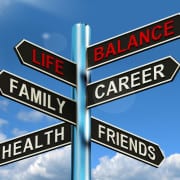What is work/life balance? Take the long-term view.
I was talking with someone recently about finding balance, and she had some interesting comments. In essence, she’s stressed out about meeting her responsibilities in the various areas of her life, and she feels guilt on top of that stress because she’s out of “balance.” Easy to understand, since we’re all supposed to be in balance these days. But, what is balance? More specifically, what is work/life balance?
We talk about balance as if it’s a concrete object or a well-defined state of being. People ask, “Am I in balance,” much as a woman might wonder whether she’s pregnant. Yes or no. I think that view is limited, limiting, and essentially unhelpful.
Balance is better understood as flow, in my opinion. For instance, I’m building my business right now. It’s been my full-time occupation for about six months, and I’ve spent a disproportionate amount of time during that six months on my business. Since I’ve made the choice to pass up a variety of recreational activities — everything from going to the movies to taking a spa vacation with a friend — it would be easy to conclude that I’m “out of balance.”
As I look at it, though, I’m working to create something. That takes a lot of time, effort, and energy. But once it’s created and sustainable, I’ll be able to refocus some of my energy elsewhere. There’s a tipping point that divides creation from existence; Newton’s First Law tells us that objects in motion tend to stay in motion; and so once I am satisfied that my business is ticking along on its own, I’ll be able to shift the creative energy from that endeavor to something else — probably R&R for a while. I’ve identified that point, so I know what I’m looking for, and when I get there chances are good that my work time will decrease somewhat, to a maintenance/slow growth level as opposed to creation.
The same is true for a lawyer who’s in trial, who’s preparing SEC filings, who’s working to get a big deal closed. It isn’t reasonable to say that we’ll work only X number of hours a day, no matter what — at least, not if we seek to be responsible professionals. At times, we need a period of (relatively) short-term extreme productivity, sustained by adequate self-care and followed by a period of replenishment.
I advocate using an Absolute Yes list to ensure balance. List your top 3-5 priorities for whatever amount of time you choose. I like to copy the list and put in places where I’ll see it frequently: in my calendar, taped to my visor in my car, in a desk drawer, etc. The list serves two functions. First, when a decision comes up, if the activity I’m considering doesn’t serve one of my Absolute Yes items, that means it’s almost certainly a NO, and I’ll pass. And second, the list reminds me to pay some attention to each priority. If I’ve gone too long — a few days, a week — without touching on one of my listed priorities, I make a special effort to include something related to that priority in my schedule.
With this system, balance is measured over the space of days and weeks, not in 24-hour blocks. It’s also a recognition that if a particular work-related item is the top priority, it’s ok for that item to take the lion’s share of time for a while. Although I’d love to suggest that we should all balance our work/family/self-care responsibilities each and every day, that’s just a recipe for frustration for most professionals. Take the long-term view instead.




Trackbacks & Pingbacks
[…] – making a short list of top priorities (similar to an Absolute Yes list, which I previously discussed in this post); […]
Leave a Reply
Want to join the discussion?Feel free to contribute!